Exposure compensation In TTL or non-TTL automatic operation with a dark subject (one with low reflectivity) or one light in tone (having high-reflectivity), over or underexposure may occur. To prevent this, exposure compensation is required. Note: If you photograph a subject of very high reflectivity such as when shooting directly into a mirror or metallic surface underexposure is certain to occur In this case. take the picture on manual.
 |
 |
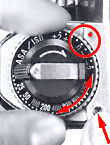 |
TTL exposure compensation |
When shooting TTL auto flash pictures, you can use the camera's exposure compensation dial (or the exposure compensation button also available when using the Nikon FG) in the normal way to make exposure compensation according to the shooting situation or to make intentionally over or underexposed photographs.
Turn the dial in the + direction to give more exposure and turn it in the opposite (-) direction to give less exposure (refer to the camera's instruction manual for more information). The TTL auto shooting range changes according to the amount of exposure compensation.
ASA/ISO film speed to set, for TTL exposure compensation
|
Exposure compensation/ Film Speed in use |
+2 |
+1 |
0 |
-1 |
-2 |
|
25 |
|
|
25 |
50 |
100 |
|
50 |
|
25 |
50 |
100 |
200 |
|
100 |
25 |
50 |
100 |
200 |
400 |
|
200 |
50 |
100 |
200 |
400 |
880* |
|
400 |
100 |
200 |
400 |
880* |
|
|
880* |
200 |
400 |
880 |
|
|
|
1000* |
250 |
500 |
1000 |
|
|
|
|
Not possible; make the necessary compensation in the non-TTL automatic mode (see the following) or shoot on manual |
||||
* For Nikon F-501/N2020 and F-301/N2000 only
 |
 |
Non-TTL automatic exposure compensation |
In the non-TTL automatic exposure mode, exposure compensation can be performed by stopping down or opening up the lens. With a dark subject, use a smaller aperture. When a subject is light in tone, use a larger aperture.
Ready Light After the ON/OFF switch is turned on, the ready-light at the back of the SB-16 lights up to indicate that the SB-16 is recycled and ready to fire. At the same time, the ready light inside the viewfinder of all Nikon F3-series cameras, in addition to the FA, FE2, FM2, FE, F-501/N2020, F-301/N2000, FG, FG-20, EM and Nikonos-V also lights up. Thus, without removing your eye from the eyepiece, you can tell when the flash unit is ready for the next shot.
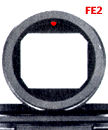 |
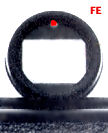 |
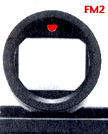 |
  |
|
| <<<---- F501; F301 Nikon FG, FG-20 ---->> | ||||
Notes: 1) With the Nikon FA, FE2, F-501/N2020, F-301/N2000,
FG, EM. FG-20 or Nikonos-V, the meter must first be turned on by depressing the shutter
release button halfway to activate the ready-light function. 2)The ready-light will light
up when the SB-16 is recycled to approx. 80% full capacity Therefore, It is a good
idea to wait for a few more seconds when shooting subjects located at the far limit
of the auto shooting range. 3) With alkaline-manganese
batteries, if the ready-light takes more than 30sec. to light up, you should replace
the batteries with a fresh set. 4) The voltage of
NiCd batteries decreases rapidly when their power is almost exhausted, increasing
the recycling time. When this occurs, stop using them immediately and recharge them
or they may be damaged.
Warning functions In the
TTL or non-TTL automatic mode, both the ready lights on the flash unit and in the
camera's viewfinder blink for 3 seconds after the flash unit fired at its maximum
output, indicating that the light might have been insufficient for correct exposure.
In this case, check the subject distance and if it is out of the automatic shooting
range, use a wider aperture if possible or move closer to the subject. Because the
voltage of batteries decreases with use, the guide number might also be reduced slightly.
The flash output of the SB-16 depends on the available ambient light and the reflectivity
of the subject. Note that, because of these factors, the ready-light may blink to
indicate that the light output was insufficient for correct exposure, even if the
subject is within the auto shooting range. Other warnings shown by the ready-light's
blinking vary according to the type of flash unit and the camera in use.
With the SB-16A As soon as the flash
unit is turned on, both ready~lights blink in the following cases: 1) When
the AS-8's mounting foot is not securely locked. 2) When using the TTL mode
with the Nikon F3-series camera and the camera's film speed setting is set well beyond
the usable range of ASA/ISO 25-400 without exposure compensation. 3) When
the shooting mode selector is set at TTL with any camera other than the Nikon F3-series.
Note that when the shutter speed
setting on the Nikon FE or FM2(n) is improper for correct flash synchronization and
the camera's meter is on (only
in the case of the FE),
just the camera's ready-light blinks as a warning, while the one on the flash unit
does not blink but simply lights up to indicate when the flash is ready to fire.
|
Camera |
Shutter Speed (sec) |
Shooting mode |
SB-16's Ready Light |
Camera's Ready Light |
|
|
meter-ON |
meter-OFF |
||||
|
F3 models* |
all settings |
TTL |
lights up* |
lights up* |
lights up* |
|
A1, A2, N, MD |
lights up* * |
lights up* * |
lights up* * |
||
|
FA via AS-6 |
all
settings except M250 & B |
TTL |
|
|
Does not lights up |
|
A1, A2, N, MD |
lights up* * |
lights up* * |
Does not lights up |
||
|
M250
& B |
TTL |
|
|
|
|
|
A1, A2, N, MD |
lights up* * |
|
lights up* * |
||
|
FE2 via AS-6 |
all settings except M250 & B |
TTL |
|
|
Does not lights up |
|
A1, A2, N, MD |
lights up* * |
lights up* * |
Does not lights up |
||
|
M250 & B |
TTL |
|
|
|
|
|
A1, A2, N, MD |
lights up* * |
|
lights up* * |
||
|
FE via AS-6 |
AUTO, 125 & slower |
TTL |
|
|
|
|
A1, A2, N, MD |
lights up* * |
|
lights up* * |
||
|
250 & faster |
TTL |
|
|
|
|
|
A1, A2, N, MD |
lights up* * |
|
lights up |
||
|
FM2(n)
via AS-6 |
250 & slower |
TTL |
|
|
|
|
A1, A2, N, MD |
lights up* * |
lights up* * |
lights up |
||
|
500 & faster |
TTL |
|
|
* * * |
|
|
A1, A2, N, MD |
lights up* * |
|
|
||
|
FM2
via AS-6 |
X200, 1/200 & slower |
TTL |
|
|
|
|
A1, A2, N, MD |
lights up* * |
lights up* * |
lights up |
||
|
250 & faster |
TTL |
|
|
|
|
|
A1, A2, N, MD |
lights up* * |
|
|
||
|
F501, F301 via AS-6 |
all settings |
TTL |
|
|
Does not lights up |
|
A1, A2, N, MD |
lights up* * |
lights up |
Does not lights up |
||
|
FG via AS-6 |
all settings except M90 & B |
TTL |
|
|
Does not lights up |
|
A1, A2, N, MD |
lights up* * |
lights up* * |
Does not lights up |
||
|
M90 & B |
TTL |
|
|
|
|
|
A1, A2, N, MD |
lights up* * |
|
lights up* * |
||
|
FG20, EM via AS-6 |
all settings except M90 & B |
TTL |
|
|
Does not lights up |
|
A1, A2, N, MD |
lights up* * |
lights up* * |
Does not lights up |
||
|
M90 & B |
TTL |
|
|
|
|
|
A1, A2, N, MD |
lights up* * |
|
lights up* * |
||
|
Nikonos V via V-type cord, AS-6 |
all settings except M90 & B |
TTL |
|
|
Does not lights up |
|
A1, A2, N, MD |
lights up* * |
lights up* * |
Does not lights up |
||
|
M90 & B |
TTL |
|
. |
|
|
|
A1, A2, N, MD |
lights up* * |
. |
lights up* * |
* Except Nikon F3P, F3H with DE-5 prism
* It blinks when the film speed setting on the camera is beyond the usable range for the TTL mode or when the mounting foot is not securely locked.
* * It blinks when the mounting foot is not secure/y locked
* * * It blinks irregularly
Note: With a mechanical shutter speed set on the camera, the camera's exposure meter remains off even if you depress the shutter release button.
With the SB-16B As soon as the flash unit is turned on, the ready-light on the flash unit lights up when the flash is ready to fire, while the ready-light in the camera's viewfinder blinks in the following cases: 1) When the shooting mode selector is set at TTL with any camera other than the Nikon FA, FE2, F-501/N2020, F-301/N2000, FG, or Nikons-V. 2) When using the FA, FE2, FG or Nikonos-V to perform TTL automatic flash photography with the camera's shutter speed dial set at a mechanical setting (M250, M90 or B). The B setting on the F-501/N2020 and F-301/N2000 camera is not a mechanical setting; you can use any setting on the camera's shooting mode selector. 3) When using the FA, FE2, F-501/N2020, F-301/N2000, FG or Nikonos-V to perform TTL automatic flash photography with a camera film speed setting over the usable range, without exposure compensation (or when using DX-coded film with film speed higher than ISO 1000 for the F-501/N2020 and F-301/N2000).
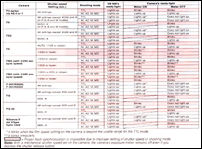 |
|
With the FA, the ready-light also blinks when the film speed setting on the camera is near ISO 12, with or without exposure compensation in the + direction. 4) When the shutter speed setting on the FM2 or FE is improper for flash synchronization and the camera's meter is on (only in the case of the FE).
|
Camera |
Shutter Speed (sec) |
Shooting mode |
SB-16's Ready Light |
Camera's Ready Light |
|
|
meter-ON |
meter-OFF |
||||
|
F3 models* via AS-4, AS-7 |
all settings |
TTL |
lights up |
|
|
|
A1, A2, N, MD |
lights up |
lights up |
lights up |
||
|
F3 models* via AS-17 |
all settings |
TTL |
lights up |
lights up |
lights up |
|
A1, A2, N, MD |
lights up |
lights up |
lights up |
||
|
| Part
I | Part
II | Part III | Part IV | Part V | Part V | Back to Index of Nikon Flash Back to Index of Nikon SB-16 Back to Index of Nikon F3 Model |
|
|||||
|
|||||||
